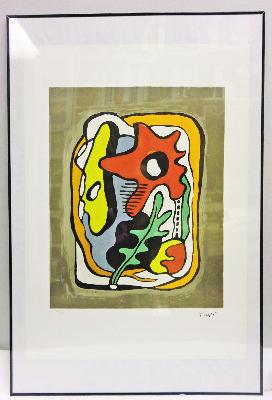- Artist: Fernand Leger (1881-1955)
- Publisher: Musee Fernand Leger, Biot (blindstamp clearly visible)
- Paper Type: Rives B.F.K.
- Image Size: 16 1/2in W x 21in H
- 21 1/4in W x 30in H
- Edition: 150 of 225
- Signed: Stamped (After) Signature from Fernand Leger
Artist Bio:
Fernand Leger was born at Argentan, France, on 4 February 1881. Leger began his career as an artist by serving an apprenticeship in architecture in Caen and working as a architectural draughtsman. In 1900 Leger went to Paris and was admitted to the ecole des Arts Decoratifs in 1903 and also attended the Academie Julian. The first profound influence on Leger's work came from Cezanne, whose pictures Leger encountered at the large-scale Cezanne exhibition at the 1907 Salon d'Automne.
Leger became friends with Delaunay and maintained ties with great artists, including Matisse, Rousseau, Apollinaire and leading exponents of Cubism. From 1909 Leger himself developed a quirky Cubist style, distinguished by reduction to the simplest basic forms and formal austerity linked with a pure, sharply contrasting palette by 1913-14. As a painter Fernand Leger exerted an enormous influence on the development of Cubism, Constructivism and the modern advertising poster as well as various forms of applied art.
From 1911 until 1912 Leger belonged to the Section d'Or group. During the first world war Leger came into contact with modern technology, notably cannon. The superhuman powers and precise beauty of ordnance enthralled him.
By 1920, influenced by the persuasive assurance radiated by Purism and the form of retro Neo-Classicism practiced by Picasso and others, Leger had achieved a mechanistic classicism, a precise, geometrically and harshly definitive monumental rendering of modern objects such as cog-wheels and screws, with the human figure incorporated as an equally machine-like being.
Surrealism also left its mark on Fernand Leger in the 1930s, loosening up his style and making it more curvilinear. Leger taught at Yale University and at Mills College in California from 1940 until 1945. By now his dominant motifs were drawn from the workplace and were post-Cubist in form, combined with the representational clarity of Realism.
Fernand Leger died at Gof-sur-Yvette near Paris on 17 August 1955. Condition:
Full Marins in good condition.
Not taped or glued to the backing shown.
Slight crease in upper right corner in plate and some yellow/brown spots along top margin.
Bright, bold colors. Acquired in 1993, this print has been in a flat, art cabinet drawer and has never seen sunlight. This lithograph was not published during Leger's lifetime but was printed after his death by permission of his estate. This exact litho (different number) sold February 24, 1993 at the Butterfield & Butterfield auction of American, European & Contemporary Prints #2946 for $660. Leger has also sold at all the primary auction houses including Christies and Sotheby's. Poster Frame Sold Seperately. |






 International Shipping Information
International Shipping Information